What Does the Plant Base Diet Mean
Food trends come and go, but it seems that this whole plant-based diet thing is here to stay.
Brands you already know and love, like Beyond Meat, just keep dishing out new options, like the Beyond Chicken Tenders they recently introduced to restaurants across the country. Even companies you're a little less familiar are investing in the plant-based game. Plantcraft, a U.K. vegan deli meat company, recently made their U.S. debut with the introduction of vegan pâtés (pâtés are usually made from ground meat).
And people are just eating it up. In fact, the plant-based food market is expected to grow at a rate of 11.9 percent by 2027 to reach $74.2 billion, with non-dairy milks showing the most potential for growth. (Which makes sense—we see how fanatic people can get about their Oatly!)
On Instagram, though, #plantbased eating looks a lot more like rainbow-colored grain bowls and avocado-based ice creams, not meatless meatball subs.
In reality, the average plant-based diet really falls somewhere between White Castle Impossible Sliders and that acai-chia-hemp-tofu-mango-kale smoothie bowl your favorite food blogger posted last week.
"A plant-based diet means eating primarily whole plant foods rich in vitamins, minerals, fiber, antioxidants, and healthy fats," says Alexis Joseph, RD, the dietitian behind the popular blog Hummusapien.
Of course, sometimes you just need some nuggets. Plus, plant-based eating also gives you the flexibility to enjoy the occasional slice of real cheese pizza or bowl of chicken soup. If you're curious about what plant-based eating is all about, and whether it might be right for you, here's what you need to know.
What is a plant-based diet, really? Is it the same as vegan?
A plant-based diet means prioritizing plant foods—specifically minimally processed fruits, veggies, whole grains, beans, legumes, nuts, and seeds, says Joseph. What that looks like can vary from person to person, though.
For instance, if you follow a Mediterranean diet, you can easily be mostly plant-based, prioritizing items like legumes, nuts, healthy fats, fruits and veg, and avoiding fish. If you're keto, it may be a little harder to follow since the keto diet nixes more carb-rich foods like whole grains, starchy vegetables, and fruit, but it can be done. (Plant-based keto is a thing!)
And plant-based doesn't necessarily mean plant-exclusive. Though veganism is a type of plant-based diet, you don't have to cut out all animal products forever to consider yourself a plant-based eater. (Plus, not all vegan foods are inherently plant-based; egg-free brownies might be vegan, but they're not truly plant-based if they're packed with processed ingredients.)
"I consider myself plant-based because most of the foods I eat are plants," says Joseph. "That said, I also eat yogurt, cheese, eggs, and fish when I feel like it, and that's okay!"
Bottom line: Plant-based eating is more of a template that encourages focusing on plant foods, not a restrictive diet that makes things off-limits, says David Levitsky, PhD, professor of nutrition and psychology at Cornell University.
What do you eat on a plant-based diet?
Again, a plant-based diet is one that emphasizes vegetables, fruits, grains, nuts, seeds, and pulses (beans and legumes). In other words: Anything that doesn't contain meat, fish, eggs, or dairy is fair game.
"When planned appropriately, you can meet all your nutritional needs through a plant-based diet," says Ryan Maciel, RD, head nutrition coach at Precision Nutrition.

Women's Health
Instead of animal proteins, for example, you'll focus on plant-based protein sources, like beans, peas, lentils, and soy products (tofu, tempeh, and edamame), says Maciel. Nuts, seeds, and nut butters also deliver a healthy dose of protein, along with healthy fats. Heck, even whole grains provide a few grams of protein per serving.
Here are some easy ways you can add more protein to your plant-based diet:
- Tofu: Super versatile tofu provides eight grams of protein per three ounce serving.
- Tempeh: A cup of tempeh (made from fermented soybeans) contains 33 grams of protein.
- Edamame: A cup of edamame contains 18 grams of protein.
- Pea protein powders: Add protein powder into a morning smoothie or stir into a drink after an intense workout, since there's 15 g of protein in a scoop.
- Lentils: A cup of cooked lentils in stew or a salad has a solid 18 grams of protein.
- Chickpeas: A cup of chickpeas has 15 grams of protein.
- Peanuts: An ounce of peanuts has 7 grams of protein.
- Almonds: A cup of whole almonds has 30 grams of protein, along with a healthy dose of unsaturated fat.
- Spirulina: A type of blue-green algae, spirulina has a gram of protein per teaspoon.
- Quinoa: Though it counts as a grain, quinoa is actually a seed that contains eight grams of protein per cooked cup.
- Chia seeds: A small sprinkling of chia seeds in a smoothie or on some plant-based yogurt can provide about 5 grams of protein.
- Seitan: Seitan is a little more processed and not an option for gluten-free eaters, but it's a complete protein, with 16 grams in a 3-ounce serving.
- Ezekiel bread: A bread made from sprouted grains, Ezekiel bread is super easy to digest and has a whopping 5 grams of protein per slice.
Once you've got your protein covered, try to eat as wide a variety of fruits and vegetables as possible, since eating different colored produce can help you get the different nutrients you need. For example, while dark leafy greens are a good source of iron and calcium, wild mushrooms provide vitamin D, Maciel says.
What kinds of foods should you limit or avoid on a plant-based diet?
If your particular flavor of a plant-based diet is plant-exclusive, and you follow a vegan diet, all meat, fish, dairy, and egg products are off the table. You'll also need to steer clear of sneaky ingredients, like whey or casein (milk derivatives) and gelatin (made from animal bones), which are commonly used in processed foods, says Maciel.
If you're taking a flexible approach, though, nothing is absolutely off-limits all the time. Whether you choose to eat animal foods once a day, once a week, or once a month, though, is totally up to you; however, Kim Ross, RD, a nutritionist in New York City, suggests choosing wisely. "The healthiest way to be plant-based is to limit or avoid processed animal foods, such as deli meats, processed cheese and spreads, hot dogs, and more," the nutritionist says. "Many animal foods in general have added hormones and antibiotics which can wreak havoc on the system."
Either way, since plant-based eating emphasizes whole foods, you'll want to minimize or avoid heavily-processed foods as much as possible, even if they're vegan. Opt to get your protein from chickpeas and lentils instead of processed veggie burgers, and save the store-bought vegan ice creams and cookies for special occasions.
What are the benefits of a plant-based diet?
Since a proper plant-based diet is centered around whole foods, it's rich in vitamins, minerals, antioxidants, and fiber, says dietitian Amy Gorin, RDN.
"Plant foods are packed with fiber and phytonutrients that support immunity, combat inflammation, and feed the healthy bacteria in your gut," echoes Joseph.
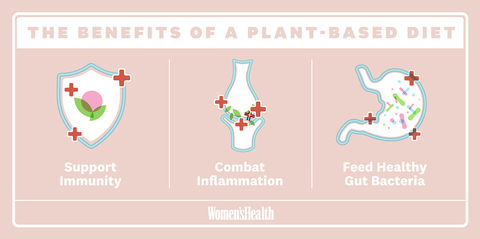
Women's Health
Swapping animal protein for plant protein has benefits, too. "Regularly consuming foods high in plant protein versus animal protein can help prevent and reverse a slew of chronic conditions, including diabetes and heart disease," says Joseph. (The nutrients found in plants help support healthy cholesterol, blood pressure, and blood sugar levels.) Plant-based diets have been linked to a lower risk for heart disease, diabetes, and some cancers.
Another major reason people choose to eat plant-based? Cutting back on animal products has significant environmental benefits.
"Eating more plant foods reduces your carbon footprint since livestock production is responsible for a good portion of global greenhouse gas emissions," says Joseph. In fact, one serving of meat contributes to more greenhouse gas emissions than twenty servings of vegetables, she says.
One study published in the Proceedings of the National Academy of Sciences suggests that transitioning to more plant-based diets could reduce global mortality by 6 to 10 percent, and food-related greenhouse gas emissions by 29 to 70 percent—when compared with a reference scenario for the year 2050. In addition, a 2013 study aimed at physicians advising patients asks them to consider recommending a plant-based diet to all their patients, especially those with high blood pressure, diabetes, cardiovascular disease, or obesity.
Others, still, go plant-based to support weight loss, which can totally work if you keep calories in check. A 16-week study which compared overweight participants following a vegan, plant-based diet to a control group found that the plant-based vegan diet proved to be superior to the control diet in improving body weight, fat mass, and insulin resistance markers, suggesting its benefits for both diabetes and weight loss.
Plant foods are high in filling fiber and low in calorie-dense saturated fats, Levitsky says—but you'll still need to consume fewer calories than you burn.
Wait, is it possible to get enough nutrients from plants?
One common criticism of plant-based eating: that it's tough to get adequate nutrients—especially protein, iron and omega-3s.
Well, it's totally doable. Though you may need to think outside the box sometimes, eating a wide mix of plant-based foods helps ensure you get the nutrients you need. "Deficiencies rarely occur when you eat a variety of plants," says Levitsky.
On protein...
When it comes to protein, don't stress too much. "It's important to note that protein isn't just found in meat," says Joseph.
Although plants contain incomplete proteins (while animal products contain complete proteins), eating different sources of plant proteins daily helps you get in all the amino acids you need to support healthy body functions, says Gorin.
You can also sneak more into your diet by adding nutritional yeast to pasta instead of grated cheese, blending white beans or chickpeas into smoothies, and snacking on nuts and nut butters.
This content is imported from {embed-name}. You may be able to find the same content in another format, or you may be able to find more information, at their web site.
Just focus on whole foods, as opposed to relying on processed meat substitutes.
On iron...
Another nutrient of concern for plant-based eaters? Iron.
"Your body absorbs heme iron, the type found in animal products, more easily than it does plant-based (a.k.a. non-heme) iron, like that found in spinach," says Gorin.
You can make plants' iron more bioavailable, though, by pairing it with vitamin C-containing foods, Gorin says. Example: If you're eating a spinach salad, squeeze some lemon juice on top.
On omega-3s....
Since most people get their omega-3s from fatty fish, they can be hard to come by on a plant-based diet. But remember that you can still consume fish even on a plant-based diet. To get the omega 3's your body needs, incorporate two servings of seafood per week (8 ounces, per the FDA recommended guidelines). Other sources of omega-3s on a plant-based diet include walnuts, flax seeds, chia seeds, and algae. A study in the Journal of the Academy of Nutrition & Dietetics actually found that people who follow vegan diets, on average, have intakes above the recommended amounts for omega-3 fats.
However, if you're struggling to incorporate these foods daily into your diet, you can have a supplement made from algae, which is a good source of these healthy fats. In fact, Gorin takes algae omega-3 supplements herself. Omega-3s are vital for brain health, so make sure you don't skimp.
What are the potential downsides of plant-based diets?
Plant-based eating is a safe and healthy choice for most people, but you should always talk with your doctor or a registered dietitian before making big changes to your diet.
"Anyone with a history of eating disorder or disordered eating shouldn't follow a diet that eliminates food groups," says Joseph. "A plant-based diet in the wrong hands can be abused as another restriction diet."
If that hits close to home for you, Joseph recommends experimenting with plant-based recipes, but steering clear of any strict food rules and restrictions, or labeling your eating habits.
How do you transition to a plant-based diet?
Switching to a plant-based diet may sound daunting, but it's important to take it one step at a time. Here are eight simple tips and tricks to help ease your transition.
1. Start small.
If you're ready to start eating more plants, Joseph recommends starting small. "Overturning your entire diet in a day is overwhelming and lessens the likelihood of you sticking with it," she says. "Instead of jumping to extremes, pick two small changes to implement each week." For example, one easy small step you can take is swapping mayo for another creamy option, like hummus, or baking with a flax egg instead of a real egg.
2. Be realistic.
Remember, a plant-based diet doesn't mean you can never eat animal products again. So, instead of focusing on taking things away, "think about how you can enhance your diet," says Joseph. "Research suggests that following a flexitarian diet (which increases plant-based foods and reduces, but doesn't eliminate, animal foods) yields similar health benefits, like reduced risk of heart disease and diabetes."
3. Try Meatless Mondays.
If you simply don't know where to begin, Meatless Mondays can be a huge help. Cutting out animal products for just one day a week is relatively easy—and can still have a profound impact on the environment and your overall health, Joseph says.
4. Replace cow's milk with dairy-free milk.
Whether you put a dash of skim milk in your morning coffee or fill up your cereal bowl with 2 percent, swapping the little bits of cow's milk in your life for a dairy-free alternative is an easy and approachable way to ease into plant-based life. Ross is a fan of oat milk and almond milk, but there are a bunch of other options, too. Just be weary that some dairy-free milks can be high in sugar, so choose something that works with your nutrition goals.
5. Rethink breakfast.
"Another option is to swap your morning bacon and eggs for oatmeal with banana, raisins, coconut flakes, and chopped nuts," says Ross. Breakfast is one of the easier meals to control since it's typically eaten at home, and this plant-based menu will still ensure you get all the protein and nutrients you need to start your day off right.
6. Meet meat in the middle.
If you're not yet ready to give up your favorite meat-based recipes, try swapping just half of the meat for a plant-based option. This might mean subbing half of the beef in your burgers or meatballs for mushrooms.
7. Go vegan for one meal a day.
If going plant-based 100 percent of the time isn't in the cards for you, consider going full vegan for just one meal a day to create a good balance. "If that is not doable perhaps you can fill your plate with 80 percent to 90 percent plant foods such as sweet potato, asparagus, greens, and roasted beets and then add a small portion of fish (about 10 percent to 20 percent of the plate)," Ross notes.
8. Eat foods you love.
Just because you're opting for a plant-based diet does not mean you have to give up all of your favorites. Instead, get creative, and swap out meat for one of the many meat alternatives now available, or the less-than-healthy ingredients for healthier ones. For example, try making a portobello burger at home instead of heating up a store-bought burger patty, or attempting to make your own froyo using real fruit and dairy-free milk, as opposed to buying a tub of ice cream. As long as you keep your meals and snacks fun and exciting, you won't get bored of a plant-based diet.
Don't know where to start? Here's a sample day of plant-based eating.

HUMMUSAPIEN
Joseph loves adding chopped apple to vegan pancakes made with whole-wheat flour for a satisfying and well-rounded breakfast.
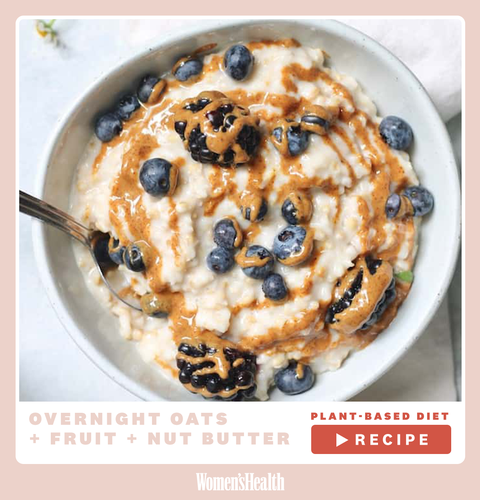
HUMMUSAPIEN
If you don't have time for pancakes in the morning, Joseph recommends whipping up a batch of steel-cut overnight oats, which you boil for a few minutes on the stove and then store in the refrigerator overnight. (Standard oatmeal is a great choice, too!) In the morning, she stirs in some fruit and nut butter.
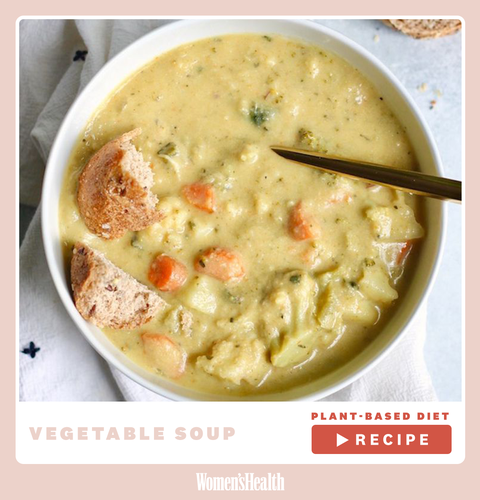
HUMMUSAPIEN
Want a re-heatable winter lunch option sans meat? It's totally possible to make a hearty, meatless, dairy-free soup with potatoes, broccoli, cauliflower, non-dairy milk, and other tasty plant-based foods.
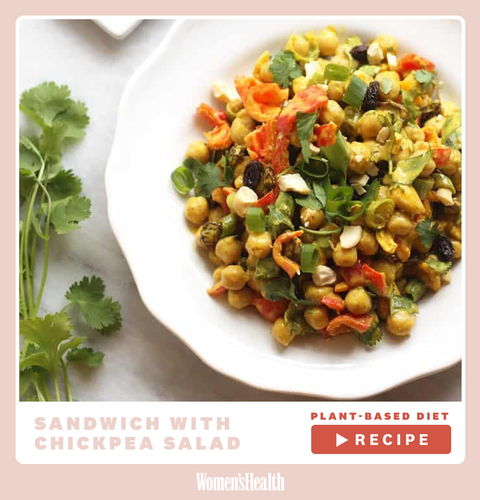
HUMMUSAPIEN
If soup isn't your jam, try topping a filling a sandwich with greens and chickpea salad (instead of chicken or egg salad).

Getty Images
Since they contain filling fiber and protein, pulses and whole grains are musts on a plant-based diet. For an afternoon pick-me-up, pair a quarter cup of hummus with a small toasted pita and a cup of raw veggies for dipping.
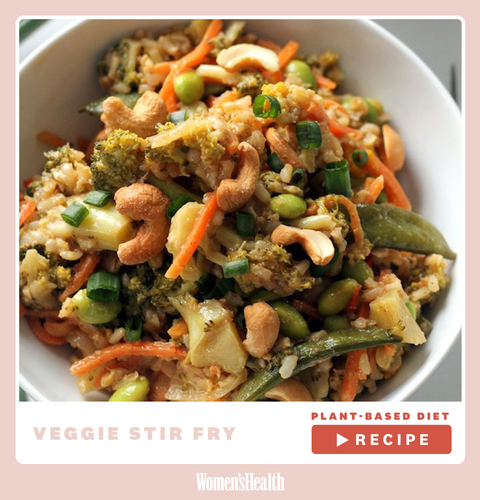
HUMMUSAPIEN
You don't need beef or shrimp for a tasty stir-fry. Serve this easy vegetable dish over brown rice and you'll have a satisfying dinner in under 30 minutes.
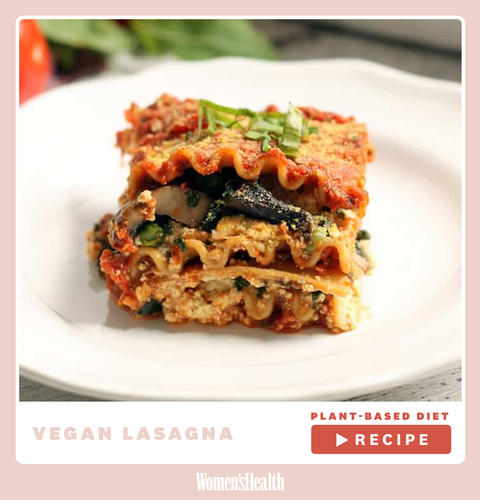
HUMMUSAPIEN
If you need something a little more comforting, there's always lasagna. The plant-based version of this carb-filled casserole gets its lasagna-ness from tofu ricotta, made with herbs, hummus, and nutritional yeast.
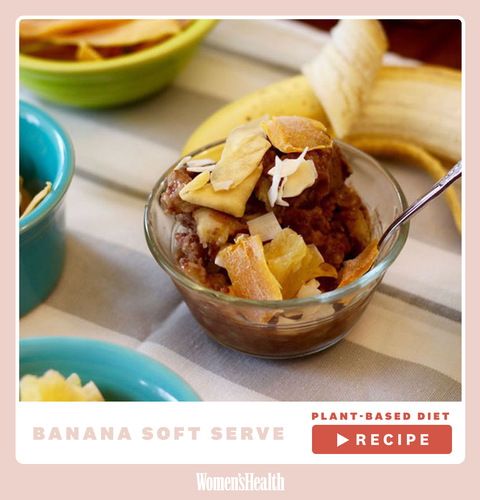
AMY GORIN NUTRITION
There are plenty of dairy-free ice cream options out there, but if you're looking for a whole foods-based treat, banana soft serve is your best friend. Gorin loves blending frozen bananas with cocoa powder, and adding healthy toppings like nuts and shredded coconut.
Ready to shop? This plant-based diet grocery list covers all of your bases.

Women's Health
The bottom line: Think of plant-based eating as a template that encourages more whole plant foods, instead of as a restrictive diet that makes all animal foods off limits.
Gabby Shacknai Gabby Shacknai is a New York-based journalist and editor who produces high-quality content for a wide variety of outlets and brands across various industries.
Christine Byrne Christine is a food writer and recipe developer in Durham, North Carolina.
Nikhita Mahtani Deputy Editor Nikhita Mahtani is an NYC-based freelance journalist covering primarily health and design.
This content is created and maintained by a third party, and imported onto this page to help users provide their email addresses. You may be able to find more information about this and similar content at piano.io
What Does the Plant Base Diet Mean
Source: https://www.womenshealthmag.com/food/a25804908/plant-based-diet/